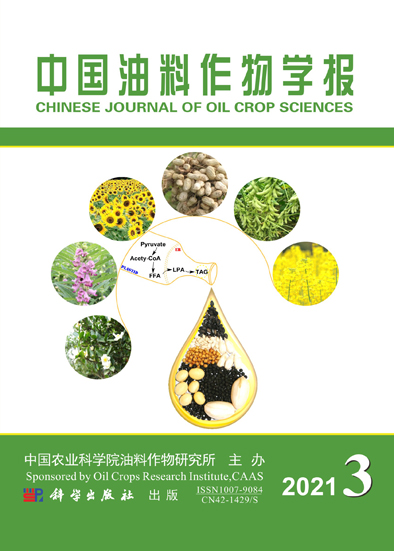YU Hai-yang, LI Yu-ying, LYU Yu-ying, ZHANG Xiu-rong, YANG Hui, ZHANG Kun, WANG Lin, LIU Feng-zhen, WAN Yong-shan
In order to investigate the genetic model of oil content in high-oil peanut line Nongda D666, four F2 populations(DP, PD, SD, 3D)were constructed using Nongda D666 as the central parent. Meanwhile, using the parents of Nongda D666, Fenghua 2 and Krapt.st.16, two F2 populations of positive and reciprocal crosses(FP, PF)were constructed. The six F2 populations were used to analyze the main gene+polygene genetic model of oil content. Oil content in the six F2 populations had wide genetic variations and transgressive segregation, which showed a con⁃
tinuous distribution, consistented with the genetic distribution characteristics of quantitative traits. There was little difference in oil content between parents of DP or PD, and the mean oil content of F2 populations were higher, which were 54.29% and 54.02%, the coefficient variations(CV)were 3.38% and 3.90%, respectively. There was significant difference in oil content between parents of SD or 3D, the average oil contents of their F2 populations were only 52.66% and 51.75%, and their CV were 5.51% and 6.24%, respectively. The average oil contents of F2 populations in FP and PF were 50.30% and 51.52%, and CV were 6.30% and 6.00%, respectively. The six populations were in accordance with three genetic models. In DP and PD, the inheritance of oil content was fitting none major gene mod⁃ el(0MG), and was controlled by polygenes. In SD and 3D, it fitted the two major gene model with additive-dominant-epistatic effect(2MG-ADI), both additive and dominant effects were positively regulated, and additive effect was dominant. The heritabilities of major genes was 33.64% and 37.80%, respectively. The gene effect values in the two populations were similar, and the synergistic genes were inherited from the high oil parent. In FP and PF, inheri⁃
tance of oil content fitted two major genes model with equal dominant effect(2MG-EAD), and the heritabilities of the major genes were 51.17% and 63.56%, respectively. The inheritance pattern of the positive and reverse crossing combination was the same, indicating that the oil content is dominated by nuclear inheritance, the additive effect is positive, and the synergistic genes were inherited from the high oil parent. Comprehensive analysis showed that the transgressive inheritance of oil content in Nongda D666 was controlled by two major genes inherited from Krapt.St.16 and polygenes with additive genetic effects.
